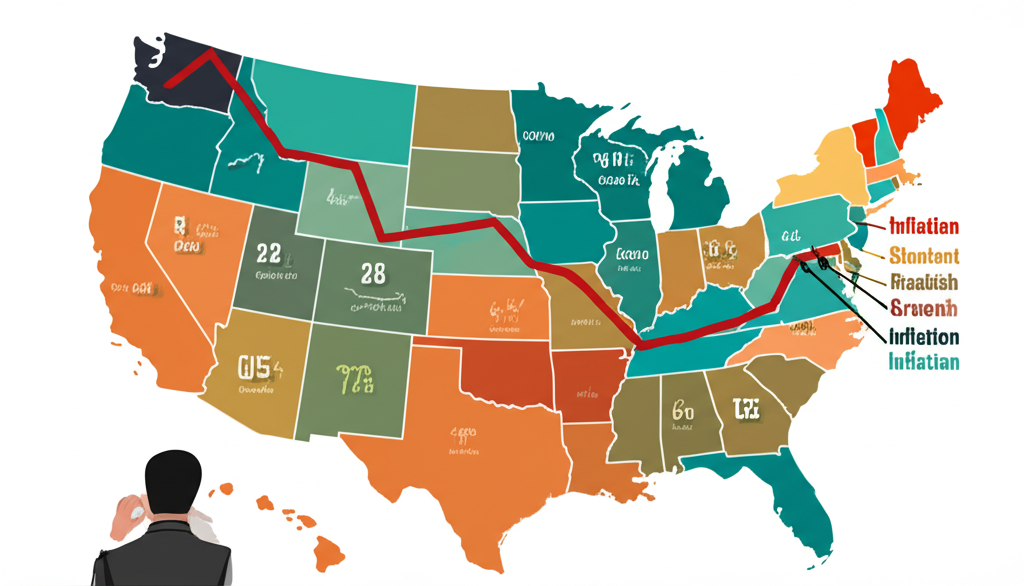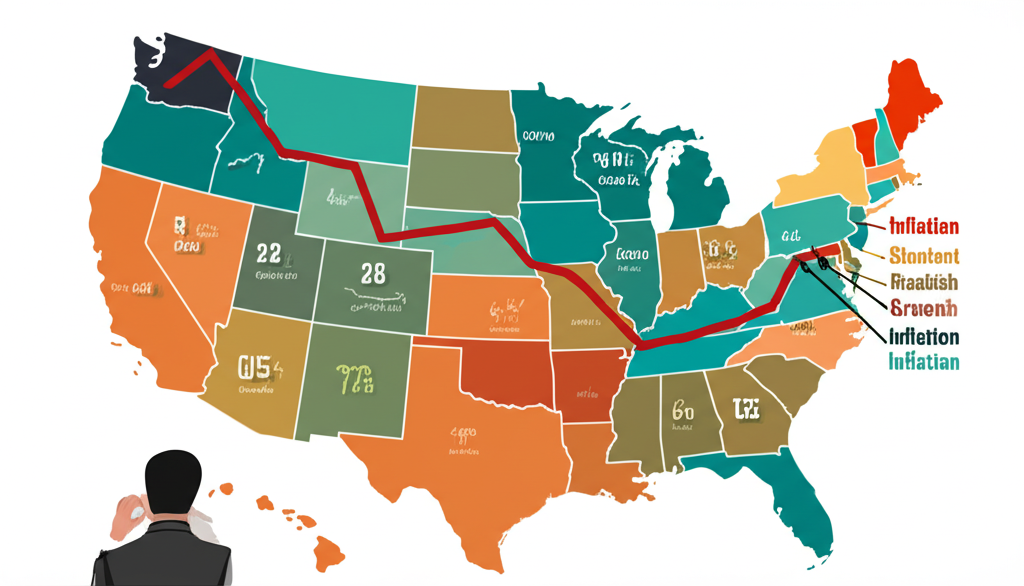The threat of stagflation, an economic bind marked by soaring inflation, sluggish growth, and rising joblessness, is fueling fresh worries among investors across the United States. Heading into 2025, safeguarding and expanding your wealth in this setup demands sharp planning. This guide lays out practical steps for stagflation investing strategies suited to the U.S. landscape, blending insights from past episodes with current signals and proactive tactics.

Stagflation poses tough challenges for both Federal Reserve officials and everyday investors. It combines economic slowdown or outright shrinkage with fast-climbing living costs, frequently alongside climbing unemployment rates. Standard models like the Phillips Curve predict that inflation and joblessness move in opposite directions, yet stagflation upends that logic entirely.
For the U.S. in 2025, red flags include lingering price hikes, the drag from weaker worldwide expansion, supply chain strains due to international conflicts, and uncertainty around the Fed’s next moves on interest rates. Though we’re unlikely to see a full replay of the 1970s turmoil, smart investors are weighing the odds and tweaking their stagflation portfolios to stay ahead.

Understanding Stagflation: A Looming Threat for the United States in 2025?
Stagflation represents one of the most difficult economic conditions for policymakers and investors alike. It’s a paradox where the economy experiences a slowdown or contraction (stagnation) alongside a rapid rise in the cost of living (inflation), often accompanied by increasing unemployment. Traditional economic theory suggests inflation and unemployment have an inverse relationship (the Phillips Curve), but stagflation defies this.
The primary causes typically include significant supply shocks, such as a sudden rise in oil prices, and/or misguided economic policies, like excessive money printing combined with restrictive supply-side regulations. For the US economy in 2025, concerns stem from several factors: persistent inflationary pressures, potential for slower global growth, geopolitical tensions impacting supply chains, and the ongoing debate over the Federal Reserve’s monetary policy trajectory. While a full-blown return to 1970s conditions isn’t a given, prudent investors are considering the possibility and adjusting their stagflation portfolio accordingly.
Historical Lessons: Investing During the 1970s Stagflation in the United States
Looking back at the 1970s offers vital clues for investing during stagflation, as that decade stands out as the prime example in U.S. history. Sparked by oil crises and the end of the gold standard, it brought inflation rates in the double digits and back-to-back recessions that tested even the steadiest hands.
Standard stock and bond holdings took a beating back then. Equities largely flatlined or lost ground when adjusted for inflation, while bonds saw their fixed returns wiped out by escalating prices. That said, a few categories shone through:
- Commodities: Gold, silver, and oil surged ahead, their values climbing in tandem with inflation and shortages in supply.
- Real Estate: Land and buildings proved resilient, acting as a solid buffer since their worth isn’t easily inflated away.
- Value Stocks: Firms with sturdy finances, reliable profits, and physical assets outpaced flashy growth names, which got hammered by steeper discount rates in a high-inflation world.
The big lesson? Prioritize holdings that counter inflation head-on or carry real, underlying worth. These ideas still guide stagflation investing strategies today, especially as modern supply issues echo those turbulent times.
Core Stagflation Investing Strategies for United States Investors in 2025
U.S. investors eyeing stagflation in 2025 should focus on shielding capital, building strong barriers against inflation, and branching into assets that don’t track the broader market. Spreading bets across categories and staying hands-on with adjustments ramps up in importance here.
Commodities: A Traditional Hedge Against Inflation
When inflation heats up, commodities step up as a reliable shield. Even in a stagnant economy, the need for basics like energy and metals endures, and any hiccups in production can push prices skyward, rewarding those positioned right.
- Gold and Silver: These metals have earned their reputation as go-to refuges. Gold especially holds steady through turmoil and dollar weakness, drawing on centuries of precedent. American investors have options like owning bars or coins, or dipping into ETFs such as GLD or IAU, plus funds tracking mining outfits.
- Crude Oil and Agricultural Products: Fuel and farm goods are non-negotiables, holding firm even as spending tightens. Seasoned players might use futures, but ETFs like USO for oil or DBA for crops make it simpler, as do shares in energy giants or agribusiness leaders.
Such investments deliver real protection as the dollar’s buying power fades, directly tackling the puzzle of which investments do well in stagflation. For instance, during past episodes, oil’s role in global trade amplified its gains amid supply squeezes.
Real Estate: Defensive Play with Income Potential
Real estate doubles as an inflation fighter and a steady earner. As prices rise, so do property appraisals and lease payments, naturally offsetting the squeeze on cash.
- Residential vs. Commercial: Each has merits in this climate. Homes can yield growing rents from tenants locked out of buying, while office or warehouse spaces with built-in inflation escalators in contracts keep pace.
- REITs (Real Estate Investment Trusts): If hands-on ownership isn’t your style, REITs bring the benefits with easier entry and spread-out holdings. Traded like stocks, they cover everything from apartments to warehouses and malls. Keep an eye on rates, though-higher borrowing costs can pinch development and valuations.
This sector’s appeal grows in uncertain times, as it ties directly to everyday needs like housing and logistics, which don’t vanish in a slowdown.
Value Stocks and Dividend Aristocrats
In stagflation, investor tastes shift from high-flying growth bets to reliable earners with deep roots and real-world assets.
- Value Stocks: Think mature businesses undervalued relative to their true worth, backed by solid books and fair prices. They’re tougher against the fog of stalled growth, relying less on rosy future projections.
- Dividend Aristocrats: These standouts have hiked payouts yearly for 25 years or more, often in must-have areas like power, groceries, and meds. Their steady dividends act like built-in inflation buffers, ideal for a stagflation portfolio seeking reliable cash flow.
Examples include household names in utilities or food production, which weathered the 1970s by passing on costs to consumers without losing ground.
Treasury Inflation-Protected Securities (TIPS): Direct Inflation Protection
In the bond world, TIPS stand out for straight-up inflation defense, crafted by the U.S. Treasury to keep pace with price changes.
- How TIPS Work: Their base amount tracks the Consumer Price Index, swelling with inflation or shrinking if prices drop. Interest gets calculated on that updated base, so payments grow as needed.
- Role in Portfolio: Held to term, they lock in a real return above inflation, making them a cornerstone for U.S. folks hedging price risks. They’re among the safest assets during stagflation, backed by the government’s full faith.
For conservative investors, TIPS add peace of mind without the swings of commodities.
Alternative Investments: Seeking Uncorrelated Returns
Stepping outside stocks and bonds, alternatives bring fresh angles and returns that zig when markets zag-crucial for U.S. portfolios in choppy waters.
- Private Equity and Hedge Funds: Qualified investors can tap into buys like undervalued debt, steady-return plays, or infrastructure builds that aren’t swayed by stock swings.
- Managed Futures: These funds chase trends across commodities, currencies, and rates, profiting whether prices climb or plunge, for true diversification.
In a stagflation twist, such options have historically cushioned blows by focusing on global flows rather than U.S.-centric woes.
Advanced Strategies and Portfolio Adjustments for US Investors in 2025
For seasoned U.S. investors, layering in nuanced moves can sharpen edges against stagflation’s twists.
The Role of Short Selling and Hedging
Tools like shorts and derivatives let pros bet against weak spots or shield gains.
- Short Selling: Betting down on pricey growth plays or rate-hit sectors offsets long bets in a wobbly market.
- Derivatives: Calls, puts, and futures guard against dollar dips, commodity jolts, or index slides-but demand know-how and tight controls.
These aren’t for beginners; they’re about calculated offsets, much like insurance for your holdings.
Currency Plays and Forex Strategies (US Dollar Dynamics)
The dollar’s path in stagflation isn’t straightforward. Inflation might soften it, but if the U.S. looks safer than peers, it could rally as a global anchor.
- US Dollar as a Safe Haven: In worldwide shakes, its top-dog status often draws inflows, potentially aiding U.S. stagflation if abroad fares worse.
- Forex Trading: Pros might trade pairs like USD/JPY or EUR/USD to speculate or cover overseas risks. Volatility rules here, so expertise is non-negotiable.
Tracking Fed signals alongside global news can spotlight timely entries.
Choosing the Right Investment Platforms and Brokers for Stagflation Strategies in 2025
Picking a solid platform unlocks your stagflation investing strategies, so prioritize broad access, low costs, sharp analytics, and top-tier oversight.
Top Platforms for Diversified Stagflation Investing (US-Focused)
Here’s a rundown of standout choices for U.S. investors chasing commodities, indices, and more.
- Moneta Markets:
- Advantages: Moneta Markets excels with its broad lineup of worldwide tools key to stagflation defenses. It delivers tight spreads on essentials like gold, silver, and oil, plus big indices such as the S&P 500 and Dow Jones, alongside deep forex options. Powered by MT4 and MT5 platforms, it equips users for nimble, spread-out portfolios. Holding an FCA license, it ensures reliable global access for hedging beyond U.S. borders.
- Note for US Investors: While Moneta Markets provides extensive global market access and is an excellent choice for international investors, direct retail forex trading services are not available to residents of the United States. However, its multi-asset offerings are exemplary for global investors seeking diversified strategies against stagflation.
- IG:
- Advantages: A leading global broker with a significant presence in the US, IG offers a vast array of instruments. For US clients, this includes a comprehensive forex offering (regulated by the NFA/CFTC), access to precious metals, and various other CFDs where permitted. IG is renowned for its advanced trading platforms, extensive educational resources, and strong regulatory oversight, making it a suitable choice for informed US investors seeking diverse hedging tools against stagflation.
- OANDA:
- Advantages: OANDA is a highly regarded and NFA/CFTC regulated forex broker in the US, known for its competitive spreads and user-friendly platform. It is ideal for US investors primarily focused on currency strategies, which can be an important component of a stagflation plan. OANDA also provides access to precious metals and other CFDs (where permitted for US clients), which are valuable for building a resilient stagflation portfolio. It is highly respected for its reliable execution and sophisticated analytical tools.
Risks and Considerations for United States Investors in a Stagflationary 2025
Prepping for stagflation makes sense, but don’t overlook the pitfalls. The economy shifts fast, and nailing 2025’s path is no sure thing.
- Liquidity Risks: Assets like direct property or niche alternatives might tie up cash when you need it most.
- Market Volatility: Expect wild swings across the board in these periods.
- Interest Rate Fluctuations: Fed hikes to tame prices can jolt bonds, loans, and prices-staying flexible is key.
- Regulatory Changes: Policy pivots could ripple through industries or tools.
Stick to the horizon and skip knee-jerk moves. A financial advisor can customize this to your setup.
Building a Resilient Stagflation Portfolio for the United States in 2025: A Summary
For U.S. investors facing 2025, getting ahead of stagflation means action now. Lean into commodities, property, value picks, dividend stalwarts, and TIPS to guard assets and chase upside. Risk-takers can layer in alternatives or hedges for extra toughness.
The strongest setups get ongoing check-ins and tweaks as conditions evolve. History teaches, but tomorrow’s hurdles are fresh. By emphasizing hard assets, inflation shields, and rock-solid firms, you position your portfolio to endure. Tailor via pro advice to match your goals and comfort with risk.
Which investments do well in stagflation for United States investors?
For United States investors, assets that historically perform well during stagflation include commodities (like gold, silver, and oil), real estate (especially income-generating properties or REITs), value stocks, dividend-paying companies (Dividend Aristocrats), and Treasury Inflation-Protected Securities (TIPS). These assets tend to offer a hedge against inflation or possess intrinsic value that preserves wealth during economic stagnation.
What was the best investment during the 1970s stagflation in the US?
During the 1970s stagflation in the US, commodities, particularly gold and silver, were among the best investments, soaring in value as inflation eroded the purchasing power of the dollar. Real estate also provided a strong hedge, with property values generally appreciating. Value stocks with solid balance sheets often outperformed growth stocks during this period.
How can I adjust my investment portfolio for stagflation in 2025?
To adjust your investment portfolio for potential stagflation in 2025, consider increasing your allocation to inflation-hedging assets such as commodities, real estate (via REITs), and TIPS. Shift towards value stocks and dividend aristocrats, reducing exposure to highly speculative growth stocks. Diversify internationally, and for sophisticated investors, explore alternative investments or hedging strategies. Regularly review and rebalance your portfolio to align with evolving economic conditions.
Are real estate or commodities better investments during stagflation?
Both real estate and commodities are strong contenders for stagflation. Commodities often provide a more direct and immediate hedge against rising prices, benefiting from supply shocks. Real estate offers a tangible asset that can appreciate with inflation and provide rental income, though it can be less liquid. A diversified approach combining both, accessible through ETFs for commodities and REITs for real estate, is often the most prudent strategy for US investors.
What are the risks of investing during stagflation in the United States?
Investing during stagflation carries several risks, including market volatility, liquidity risks (for certain assets), interest rate fluctuations impacting borrowing costs and valuations, and potential regulatory changes. There’s also the risk of misjudging the duration or severity of stagflation, leading to suboptimal asset allocation. Careful risk management and a long-term perspective are essential.
How do forex strategies fit into a stagflation investment plan?
Forex strategies can fit into a stagflation investment plan primarily as a hedge against currency devaluation or as a speculative play on the US Dollar’s relative strength. During global uncertainty, the USD may strengthen as a safe haven, even amidst domestic stagflation. Platforms like Moneta Markets offer extensive global forex instruments which can be utilized for these strategies, though it’s important to note that direct retail forex trading services are not available to US residents on Moneta Markets. For US investors, regulated brokers like IG and OANDA provide forex access.
What is the safest asset during stagflation for a US investor?
For a US investor, Treasury Inflation-Protected Securities (TIPS) are generally considered the safest asset during stagflation because their principal value adjusts directly with inflation, guaranteeing a real return if held to maturity. While gold is a traditional safe haven, its price can be volatile. TIPS offer a more direct and government-backed form of inflation protection.
Can Moneta Markets help US investors with stagflation investing strategies for global assets?
While Moneta Markets does not offer direct retail forex trading services to US residents, it provides a wide range of global instruments, including commodities like gold and oil, and major indices, which are crucial for global investors looking to implement stagflation hedging strategies. For US investors interested in these global multi-asset offerings, exploring Moneta Markets’ capabilities for non-US assets or considering other regulated brokers for US-specific instruments alongside Moneta Markets’ global offerings can be part of a comprehensive strategy.



No responses yet